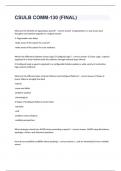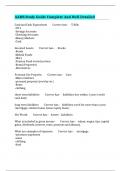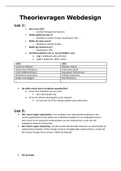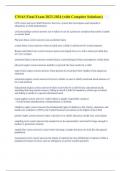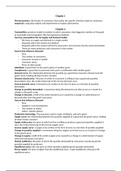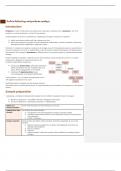Logistics and supply chain management
H1: Introduction to operations management
Operations are processes that either provide services of create goods, they
take place in every business organization
Introduction
Goods= physical items
Services= activities
The ideal situation for a business organization is to achieve an economic match
of supply and demand
The key functions on the supply side are operations and supply chains, and
sales and marketing on the demand side
à important: operations need support and input from other areas of the
organization
The tree basic functions of business organizations:
(overnemen p 4)
Finance: responsible for securing financial resources
Marketing: responsible for assessing consumer wants and needs, and selling
and promoting the organization’s goods and services
Operations: responsible for producing the goods or providing the services
Operations management= the management of systems or processes that
create goods and/ or provide services
Operations and supply chains are always linked
Supply chain= a sequence of organizations that are involved in producing and
delivering a product or service
(Figuur p 5 overnement)
,Each link is a customer of the previous link and a supplier to the following link
à If one link fails, it can interrupt the flow in the supply chain for the following
portion of the chain
The value of the product increases as it moves through the supply chain
Supply chains are both internal and external to the organization
- External: provides inputs to the organization, delivers outputs
- Internal: part of the operations function itself
To ensure that the desired outputs are obtained, an organization takes
measurements at various points in the transformation process and the
compares them with previously established standards to determine whether
corrective action is needed
(Figuur p 6 overnemen)
Production of goods versus providing services
Although goods and services often go hand in hand, there are some very basic
differences and similarities
(Tabel p 11 overnemen)
,Why learn about operations management?
Operations and sales are the two line functions in a business organization; all
other functions support these twp
Process management
A key aspect of operations management is process management
Process= consists of one or more actions that transform inputs into outputs
There are 3 categories of business processes:
1) Upper- management processes; govern the operation of the entire
organization
2) Operational processes; core processes that make up the value stream
3) Supporting processes; support the core processes
A major process can consist of many subprocesses
Business process management (BPM) activities include process design,
process execution and process monitoring
2 basic aspects:
1) Managing processes to meet demand
Ideally, output just matches demand
To make this work we need accurate forecasts of demand
2) Process variation
Due to variety of variability
4 basic sources of variation:
• Variety of goods/ services being offered; the greater the variety à
the greater the variation
• Structural variation in demand; are generally predictable
• Radom variation; natural variability
• Assignable variation; caused by defective inputs
Variations can be disruptive to operations and supply chain processes,
interfering with optimal functioning
Therefore managers must have the ability to deal with variability
Two widely used metrics: mean and standard deviation
The scope of operations management
A primary function of an operations manager is to guide the system by
decision making
Certain decisions affect the design of the system, and others affect the
operation of the system:
• System design
This are strategic decisions that require long-term commitments
• System operation
Tactical and operational decisions, decisions involve measurement and
control
, The operations manager is the key figure in the system: he or she has the
ultimate responsibility for the creation of goods or provision of services
Operations management and decision making
The chief role of an operations manager is that of planner and decision maker
It is very important to make informed decisions
Approaches to decision making:
1) Models
Model= an abstraction of reality, a simplified representation of
something
Types of models
• Physical model: look like their real-life counterparts
• Schematic models: are more abstract than their physical counterparts
• Mathematical models: are the most abstract, they don’t look at all like
their real-life counterparts
They have all certain common features; they are all decision-making
aids and simplifications of more complex real-life phenomena
Models omit unimportant details so that attention can be concentrated
on the most important aspects of the situation
Models are beneficial because they:
• Are easy to use and less expensive
• Require users
• Increase understanding of the problem
• Enable managers to analyze what-if questions
• Serve as a consistent tool for evaluation and provide a
standardized format
• Enable users to bring the power of mathematics to bear on a
problem
Certain limitations:
• Quantitative information may be emphasized at the expense of
qualitative information
• Models may be incorrectly applied and the results
misinterpreted
• Use does not guarantee good decisions
2) Quantitative approaches
Embody an attempt to obtain mathematically optimal solutions to
managerial problem
Managers typically use a combination of qualitative and quantitative
approaches, and many important decisions are based on qualitative
approaches
3) Performance metrics
Metrics to manage and control operations
H1: Introduction to operations management
Operations are processes that either provide services of create goods, they
take place in every business organization
Introduction
Goods= physical items
Services= activities
The ideal situation for a business organization is to achieve an economic match
of supply and demand
The key functions on the supply side are operations and supply chains, and
sales and marketing on the demand side
à important: operations need support and input from other areas of the
organization
The tree basic functions of business organizations:
(overnemen p 4)
Finance: responsible for securing financial resources
Marketing: responsible for assessing consumer wants and needs, and selling
and promoting the organization’s goods and services
Operations: responsible for producing the goods or providing the services
Operations management= the management of systems or processes that
create goods and/ or provide services
Operations and supply chains are always linked
Supply chain= a sequence of organizations that are involved in producing and
delivering a product or service
(Figuur p 5 overnement)
,Each link is a customer of the previous link and a supplier to the following link
à If one link fails, it can interrupt the flow in the supply chain for the following
portion of the chain
The value of the product increases as it moves through the supply chain
Supply chains are both internal and external to the organization
- External: provides inputs to the organization, delivers outputs
- Internal: part of the operations function itself
To ensure that the desired outputs are obtained, an organization takes
measurements at various points in the transformation process and the
compares them with previously established standards to determine whether
corrective action is needed
(Figuur p 6 overnemen)
Production of goods versus providing services
Although goods and services often go hand in hand, there are some very basic
differences and similarities
(Tabel p 11 overnemen)
,Why learn about operations management?
Operations and sales are the two line functions in a business organization; all
other functions support these twp
Process management
A key aspect of operations management is process management
Process= consists of one or more actions that transform inputs into outputs
There are 3 categories of business processes:
1) Upper- management processes; govern the operation of the entire
organization
2) Operational processes; core processes that make up the value stream
3) Supporting processes; support the core processes
A major process can consist of many subprocesses
Business process management (BPM) activities include process design,
process execution and process monitoring
2 basic aspects:
1) Managing processes to meet demand
Ideally, output just matches demand
To make this work we need accurate forecasts of demand
2) Process variation
Due to variety of variability
4 basic sources of variation:
• Variety of goods/ services being offered; the greater the variety à
the greater the variation
• Structural variation in demand; are generally predictable
• Radom variation; natural variability
• Assignable variation; caused by defective inputs
Variations can be disruptive to operations and supply chain processes,
interfering with optimal functioning
Therefore managers must have the ability to deal with variability
Two widely used metrics: mean and standard deviation
The scope of operations management
A primary function of an operations manager is to guide the system by
decision making
Certain decisions affect the design of the system, and others affect the
operation of the system:
• System design
This are strategic decisions that require long-term commitments
• System operation
Tactical and operational decisions, decisions involve measurement and
control
, The operations manager is the key figure in the system: he or she has the
ultimate responsibility for the creation of goods or provision of services
Operations management and decision making
The chief role of an operations manager is that of planner and decision maker
It is very important to make informed decisions
Approaches to decision making:
1) Models
Model= an abstraction of reality, a simplified representation of
something
Types of models
• Physical model: look like their real-life counterparts
• Schematic models: are more abstract than their physical counterparts
• Mathematical models: are the most abstract, they don’t look at all like
their real-life counterparts
They have all certain common features; they are all decision-making
aids and simplifications of more complex real-life phenomena
Models omit unimportant details so that attention can be concentrated
on the most important aspects of the situation
Models are beneficial because they:
• Are easy to use and less expensive
• Require users
• Increase understanding of the problem
• Enable managers to analyze what-if questions
• Serve as a consistent tool for evaluation and provide a
standardized format
• Enable users to bring the power of mathematics to bear on a
problem
Certain limitations:
• Quantitative information may be emphasized at the expense of
qualitative information
• Models may be incorrectly applied and the results
misinterpreted
• Use does not guarantee good decisions
2) Quantitative approaches
Embody an attempt to obtain mathematically optimal solutions to
managerial problem
Managers typically use a combination of qualitative and quantitative
approaches, and many important decisions are based on qualitative
approaches
3) Performance metrics
Metrics to manage and control operations


